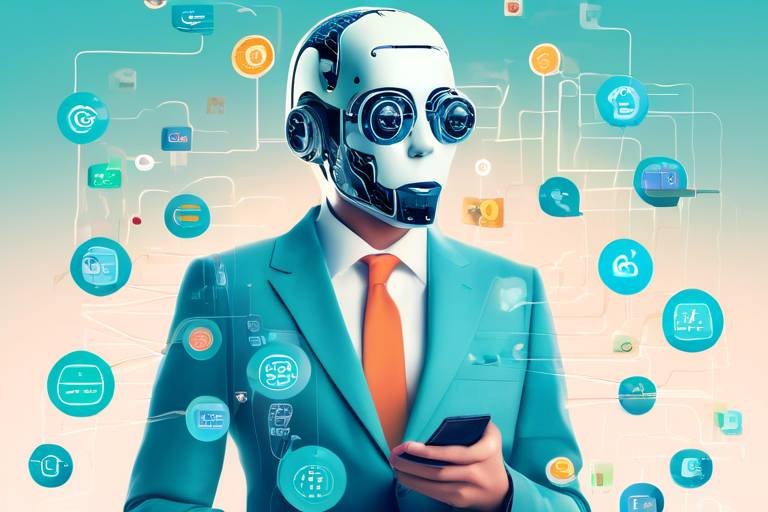Artificial Intelligence: The Future of Telemedicine
In an era where technology and healthcare are increasingly intertwined, artificial intelligence (AI) is emerging as a game-changer in the realm of telemedicine. Imagine a world where healthcare isn't confined to the four walls of a clinic or hospital; instead, it is accessible from the comfort of your own home. This is not just a dream but a reality being shaped by AI advancements. From enhancing diagnostic accuracy to providing virtual health assistants, AI is revolutionizing how we approach healthcare delivery, especially in remote settings.
The integration of AI into telemedicine is like adding a turbocharger to a car—it enhances performance and efficiency. With AI capabilities, healthcare professionals can analyze vast amounts of patient data in mere seconds, leading to quicker and more reliable diagnoses. But it doesn't stop there; AI is also helping patients feel more engaged and satisfied with their healthcare experience. As we delve deeper into this article, we will explore the transformative impact of AI on telemedicine, highlighting its advancements, challenges, and the promising future it holds.
As we journey through the world of AI in telemedicine, we will uncover how AI-driven diagnosis is reshaping the landscape of medical evaluations. We'll also take a closer look at the role of virtual health assistants and chatbots, which are becoming essential tools for patient engagement. Furthermore, we'll discuss the importance of remote patient monitoring and the critical issues surrounding data security and privacy. In this rapidly evolving field, understanding both the benefits and the challenges posed by AI is crucial for healthcare providers and patients alike.
So, buckle up as we explore the fascinating intersection of AI and telemedicine, where innovation meets compassion in healthcare delivery. The future is bright, and it's powered by artificial intelligence!
- What is telemedicine? Telemedicine refers to the delivery of healthcare services remotely, using technology to connect patients and healthcare providers.
- How does AI improve telemedicine? AI enhances telemedicine by providing tools for better diagnosis, patient engagement, and monitoring, ultimately leading to improved healthcare outcomes.
- Are there privacy concerns with AI in telemedicine? Yes, there are significant concerns regarding data security and patient privacy, which must be addressed to ensure safe and effective telemedicine practices.
- What role do chatbots play in telemedicine? Chatbots facilitate communication, provide medical information, and assist in patient screening and follow-up care, offering 24/7 support.

AI-Driven Diagnosis
Artificial intelligence (AI) is revolutionizing the way we approach diagnosis in healthcare, making it faster and more accurate than ever before. Imagine a world where your doctor can instantly analyze your symptoms and medical history with the help of AI, leading to a diagnosis that is not only precise but also tailored specifically to your needs. This is no longer a distant dream; it's happening right now. AI technologies, such as machine learning algorithms and deep learning neural networks, are being harnessed to sift through vast amounts of patient data and medical images, enabling healthcare professionals to make informed decisions.
One of the standout features of AI-driven diagnosis is its ability to process and analyze data at lightning speed. For instance, consider the traditional methods of diagnosing conditions such as cancer. Doctors often rely on imaging techniques like MRIs and CT scans. With AI, these images can be analyzed in seconds rather than hours, identifying anomalies that a human eye might miss. A study showed that AI algorithms could detect certain types of tumors with an accuracy rate of over 95%, surpassing many human radiologists. This not only enhances the reliability of diagnoses but also allows for quicker intervention, which can be crucial in life-threatening situations.
Furthermore, AI doesn't just stop at analyzing images; it also integrates various forms of patient data, including electronic health records (EHRs), lab results, and even genetic information. By doing so, it creates a comprehensive profile of the patient, allowing for a more holistic approach to diagnosis. For example, AI can identify patterns in a patient’s history that may indicate a predisposition to certain diseases, prompting early screenings and preventive measures. The ability to predict health issues before they escalate is a game-changer in the realm of telemedicine.
However, while the benefits of AI-driven diagnosis are clear, it's essential to acknowledge the challenges that come with it. One major concern is the interpretability of AI decisions. Healthcare professionals need to understand how AI arrives at its conclusions to trust its recommendations fully. This transparency is crucial, especially when making critical health decisions. Moreover, there are concerns regarding data privacy and the ethical implications of relying on AI for diagnosis. Ensuring that these systems are designed with robust security measures and ethical guidelines is paramount to gaining public trust.
To sum it up, AI-driven diagnosis represents a monumental shift in healthcare, offering unprecedented accuracy and speed. As we continue to explore its potential, collaboration between AI developers and healthcare professionals will be vital in overcoming the challenges and maximizing the benefits. The future of telemedicine is undoubtedly bright, and AI is at the forefront of this transformation.

Virtual Health Assistants
In the rapidly evolving world of telemedicine, powered by artificial intelligence are becoming indispensable. Imagine having a personal health advisor available at your fingertips, ready to answer your questions and guide you through your healthcare journey. These AI-driven tools provide patients with immediate access to a wealth of medical information and support, transforming the way we interact with healthcare services.
One of the most significant advantages of virtual health assistants is their ability to enhance patient engagement. With the help of these digital companions, patients no longer have to wait for appointments or navigate complex healthcare systems alone. Instead, they can receive tailored information and support at any time, making healthcare more accessible than ever. This immediacy not only boosts patient confidence but also improves overall satisfaction with telemedicine services.
Moreover, virtual health assistants can help bridge the gap between patients and healthcare providers. They offer a variety of functionalities, including:
- Symptom assessment: Patients can input their symptoms and receive preliminary advice on potential conditions.
- Medication reminders: These assistants can send notifications to ensure patients adhere to their treatment plans.
- Appointment scheduling: Virtual assistants can facilitate the booking of appointments, reducing administrative burdens on healthcare staff.
However, while the benefits are significant, there are challenges to consider. Issues such as accuracy of information and the potential for miscommunication can arise. It's crucial for patients to remember that while these assistants can provide valuable insights, they should not replace professional medical advice. Instead, think of them as a supplementary resource that can enhance the overall healthcare experience.
In conclusion, virtual health assistants are revolutionizing the way patients interact with healthcare systems. Their ability to provide timely assistance and information not only empowers patients but also paves the way for a more efficient telemedicine landscape. As technology continues to advance, we can expect these digital companions to become even more sophisticated, further enriching the patient experience.
- What is a virtual health assistant? A virtual health assistant is an AI-powered tool designed to provide patients with immediate access to medical information and support.
- How do virtual health assistants improve patient engagement? By providing timely information and support, virtual health assistants empower patients to take charge of their healthcare, leading to increased satisfaction.
- Can virtual health assistants replace healthcare providers? No, while they offer valuable insights, virtual health assistants should complement, not replace, professional medical advice.
- What are the limitations of virtual health assistants? Limitations can include the accuracy of information provided and potential miscommunication, so it’s essential for patients to verify information with healthcare professionals.

Chatbots in Telemedicine
In the ever-evolving landscape of telemedicine, chatbots have emerged as a revolutionary tool that bridges the gap between patients and healthcare providers. Imagine having a virtual assistant at your fingertips, ready to answer your health-related queries at any hour of the day or night. That's precisely what chatbots offer! These AI-driven applications provide a level of accessibility and convenience that traditional healthcare methods simply cannot match.
Chatbots serve multiple purposes in telemedicine, functioning as the first point of contact for patients seeking medical advice. They can handle a variety of tasks, from scheduling appointments to providing symptom checks. This not only enhances the patient experience but also frees up valuable time for healthcare professionals to focus on more complex cases. But how do these digital assistants actually work? They utilize natural language processing (NLP) to understand and respond to patient inquiries, creating a seamless interaction that feels surprisingly human-like.
One of the standout features of chatbots in telemedicine is their ability to provide 24/7 assistance. Whether it’s the middle of the night or during a holiday, patients can receive immediate responses to their questions. This is particularly beneficial for those who may feel anxious about their health and need quick reassurance. Think of it as having a personal health consultant available at all times!
However, while chatbots offer numerous benefits, they are not without limitations. For instance, they may struggle with complex medical inquiries that require a nuanced understanding of a patient's history or condition. This is where the human touch remains irreplaceable. Yet, when it comes to routine questions or basic triage, chatbots excel. They can efficiently direct patients to the appropriate resources or specialists based on the information provided.
To give you a clearer picture of their functionalities, here’s a quick look at the primary roles chatbots play in telemedicine:
- Symptom Assessment: Chatbots can ask a series of questions to help determine the severity of a patient's symptoms, guiding them on whether to seek immediate medical attention.
- Appointment Scheduling: They can manage calendars, allowing patients to book, reschedule, or cancel appointments effortlessly.
- Medication Reminders: By sending timely notifications, chatbots help ensure patients adhere to their prescribed medication schedules.
In conclusion, chatbots are revolutionizing the way we interact with healthcare services. They not only enhance patient engagement but also streamline processes for healthcare providers. As technology continues to advance, we can expect these virtual assistants to become even more sophisticated, potentially incorporating more advanced AI capabilities to better serve patient needs. The future of telemedicine is bright, and chatbots are undoubtedly playing a pivotal role in shaping it.
As we navigate the fascinating world of chatbots in telemedicine, you might have some questions. Here are a few common inquiries:
- What types of questions can chatbots answer? Chatbots are designed to handle a range of inquiries, from basic symptom assessments to appointment scheduling and medication reminders.
- Are chatbots secure? Yes, reputable telemedicine platforms ensure that chatbots comply with data security regulations to protect patient information.
- Can chatbots replace human healthcare providers? While chatbots can assist with many tasks, they cannot replace the personalized care and expertise of human healthcare professionals.

Patient Screening
In the ever-evolving landscape of telemedicine, AI-driven chatbots have emerged as vital tools for . Imagine walking into a doctor's office, but instead of a waiting room filled with anxious patients, you’re greeted by a friendly chatbot ready to assist you from the comfort of your home. This innovative technology efficiently gathers essential information from patients prior to their consultations, making the entire healthcare experience smoother and more streamlined.
So, how does this work? Picture this: a patient logs into a telemedicine platform and is immediately greeted by a chatbot. The chatbot begins by asking a series of targeted questions designed to assess the patient's symptoms, medical history, and any other relevant data. This not only saves time for healthcare providers but also ensures that patients are adequately prepared for their appointments. By collecting this information upfront, chatbots can help identify potential issues that need addressing during the consultation, allowing doctors to focus on what truly matters—providing quality care.
Moreover, the efficiency of AI-driven patient screening can lead to significant improvements in healthcare resource management. For instance, consider the following benefits:
- Time Efficiency: By collecting preliminary information, chatbots reduce the time healthcare professionals spend on each consultation.
- Enhanced Accuracy: Chatbots can minimize human error by systematically collecting data, ensuring that no critical information is overlooked.
- Increased Access: Patients in remote areas can receive timely screenings without the need for physical travel, thereby improving healthcare accessibility.
However, it’s essential to recognize that while chatbots are a fantastic tool for patient screening, they are not without limitations. For example, they may struggle with complex medical conditions that require nuanced understanding or empathy. Additionally, there’s the challenge of ensuring that patients feel comfortable sharing sensitive information with a machine. Therefore, it’s crucial for healthcare providers to strike a balance between technology and human interaction, ensuring that patients still feel valued and understood during their healthcare journey.
In conclusion, AI-driven chatbots are revolutionizing the patient screening process in telemedicine, making it more efficient and accessible. As technology continues to advance, we can expect these tools to become even more sophisticated, ultimately leading to better patient outcomes and a more streamlined healthcare experience.
- What is patient screening in telemedicine? Patient screening in telemedicine refers to the process of collecting essential health information from patients before their consultations, often facilitated by AI-driven chatbots.
- How do chatbots enhance patient screening? Chatbots enhance patient screening by efficiently gathering data, reducing wait times, and ensuring that healthcare providers have the necessary information to offer quality care.
- Are there any limitations to using chatbots for patient screening? Yes, chatbots may struggle with complex medical conditions and may not provide the empathy that human interactions offer. It's important to use them as a complement to traditional care.

Follow-Up Care
In the realm of telemedicine, is a critical component that ensures patients stay on track with their treatment plans. With the rise of AI-driven chatbots, healthcare providers can now offer a seamless follow-up experience that significantly enhances patient engagement. Imagine having a personal assistant at your fingertips, ready to remind you of your next appointment or when to take your medication. This is the reality that AI is creating in the healthcare landscape.
AI chatbots are designed to send automated reminders and notifications, which can be customized based on the patient’s specific needs. For instance, if a patient has a chronic condition that requires regular monitoring and medication, the chatbot can provide tailored reminders that help maintain adherence to the prescribed treatment. This not only improves health outcomes but also fosters a sense of accountability among patients. After all, when you have someone—or rather, something—checking in on you, it’s easier to stay committed to your health goals.
Moreover, the data collected from these interactions can be invaluable. Healthcare providers can analyze the responses and engagement levels of patients, allowing them to identify those who may be struggling with their treatment or who require additional support. This proactive approach can lead to timely interventions, ensuring that patients do not fall through the cracks. For example, if a patient repeatedly misses medication reminders, the system can alert a healthcare professional to reach out and assess any barriers the patient might be facing.
However, it’s essential to recognize that while AI chatbots are incredibly effective, they are not a substitute for human interaction. There will always be situations where a personal touch is necessary, especially when discussing sensitive health issues. Therefore, the best approach is a hybrid model where AI handles routine follow-ups and reminders, while healthcare professionals are available for more complex queries and emotional support.
To illustrate the effectiveness of AI in follow-up care, consider the following table that summarizes key benefits:
| Benefit | Description |
|---|---|
| Increased Adherence | Reminders help patients remember their medication schedules, leading to better health outcomes. |
| Data Insights | Providers can analyze patient interactions to identify those needing additional support. |
| Time Efficiency | Automated follow-ups free up healthcare professionals to focus on more complex cases. |
In conclusion, AI-driven chatbots are revolutionizing follow-up care in telemedicine by providing timely reminders, enhancing patient engagement, and enabling healthcare professionals to deliver personalized support. As technology continues to evolve, the integration of AI in follow-up care will undoubtedly lead to improved patient outcomes and a more efficient healthcare system.
- How do AI chatbots improve follow-up care? AI chatbots send automated reminders and notifications to patients, helping them adhere to their treatment plans.
- Can AI replace human healthcare providers? No, AI is designed to complement healthcare providers, not replace them. It handles routine tasks, allowing professionals to focus on complex cases.
- What kind of data do chatbots collect? Chatbots collect data on patient interactions, which can be analyzed to identify those who may need additional support.

Remote Patient Monitoring
Remote Patient Monitoring (RPM) is revolutionizing the way we approach healthcare, especially for individuals managing chronic conditions. Imagine being able to keep tabs on your health from the comfort of your own home, without the need for constant trips to the doctor’s office. That’s the promise of AI-driven technologies in RPM. These systems utilize a variety of tools, such as wearable devices and mobile applications, to continuously collect health data, which is then analyzed using sophisticated algorithms. This seamless integration of technology not only allows healthcare providers to monitor patients in real time but also empowers patients to take control of their own health.
One of the most significant advantages of RPM is its ability to facilitate early intervention. For example, if a patient with diabetes is wearing a continuous glucose monitor, the data can be sent directly to their healthcare provider. If the readings indicate an abnormal spike in glucose levels, the provider can intervene quickly, potentially preventing serious complications. This proactive approach to healthcare is akin to having a lifeguard on duty at a swimming pool—always watching, ready to jump in when needed. The result? Improved health outcomes and reduced hospitalizations.
Furthermore, RPM can significantly enhance the patient experience. Patients often feel more engaged in their treatment plans when they have access to their health data. They can track their progress, set personal health goals, and communicate more effectively with their healthcare providers. This two-way communication fosters a sense of partnership in the healthcare journey. For instance, patients can receive tailored health tips based on their data, making their care more personalized and effective. Here’s a brief overview of how RPM benefits both patients and providers:
| Benefits | Patients | Healthcare Providers |
|---|---|---|
| Continuous Monitoring | Stay informed about health metrics | Early detection of potential issues |
| Enhanced Engagement | Active participation in health management | Better patient-provider communication |
| Convenience | Reduced need for in-person visits | Optimized resource allocation |
However, it’s essential to recognize that while RPM offers numerous benefits, it also comes with challenges. Issues such as data accuracy, technology accessibility, and patient compliance can impact the effectiveness of remote monitoring. For instance, not all patients may be comfortable using technology, and some may struggle with the devices that track their health metrics. Therefore, it’s crucial for healthcare providers to offer support and education to ensure that all patients can benefit from these advancements.
In conclusion, Remote Patient Monitoring powered by AI is not just a trend; it’s a transformative approach to healthcare that promises to make medical care more accessible, efficient, and personalized. As technology continues to evolve, we can expect even more innovative solutions that will enhance the way we monitor and manage our health from a distance.
- What is Remote Patient Monitoring?
Remote Patient Monitoring (RPM) involves the use of technology to monitor patients' health data outside of traditional clinical settings, allowing for real-time health management.
- How does AI improve Remote Patient Monitoring?
AI enhances RPM by analyzing large sets of health data to identify trends, predict potential health issues, and provide actionable insights for both patients and providers.
- What types of devices are used in Remote Patient Monitoring?
Common devices include wearable fitness trackers, smartwatches, continuous glucose monitors, and blood pressure cuffs that connect to mobile apps.
- Are there any privacy concerns with Remote Patient Monitoring?
Yes, ensuring data security and patient privacy is critical. Providers must comply with regulations like HIPAA to protect sensitive health information.

Data Security and Privacy
As telemedicine continues to evolve, the importance of data security and patient privacy cannot be overstated. With the increasing reliance on technology to deliver healthcare services, sensitive patient information is more vulnerable than ever. Healthcare providers and technology developers must prioritize safeguarding this data to maintain trust and comply with regulations. Imagine sharing personal health information over a video call; if that data is not protected, it could lead to significant breaches of privacy, potentially harming patients and providers alike.
The integration of artificial intelligence in telemedicine brings unique challenges and solutions regarding data security. AI systems often require large datasets to function effectively, which can include sensitive patient data. Ensuring that this information is securely stored and processed is critical. Many telemedicine platforms are now implementing advanced encryption methods and secure cloud storage solutions to protect patient data from unauthorized access. Encryption acts as a lock on your data, ensuring that only those with the right keys can access it.
| Data Security Measures | Description |
|---|---|
| Data Encryption | Converts data into a secure format that can only be read by authorized users. |
| Access Controls | Restricts access to sensitive information to only those who need it for their role. |
| Regular Audits | Periodic checks to ensure compliance with security protocols and identify vulnerabilities. |
| Patient Consent | Ensuring patients are informed and agree to how their data will be used and shared. |
Moreover, the ethical implications of using AI in telemedicine also raise questions about how patient data is utilized. Are patients aware of how their information is being analyzed? Are they comfortable with AI systems making decisions based on their data? Transparency is key. Patients should be informed about what data is collected, how it will be used, and who will have access to it. This not only fosters trust but also empowers patients to take control of their health information.
As telemedicine grows, regulatory compliance becomes a significant focus. Laws such as the Health Insurance Portability and Accountability Act (HIPAA) in the United States set strict guidelines on how patient information should be handled. Telemedicine providers must ensure that their AI solutions are designed to meet these legal requirements while also maintaining patient confidentiality. This is no small feat, as it requires a comprehensive understanding of both technology and healthcare regulations.
In conclusion, while the integration of AI in telemedicine offers exciting possibilities for improving healthcare delivery, it also presents substantial challenges regarding data security and privacy. As we move forward, it is crucial for all stakeholders—healthcare providers, technology developers, and patients—to work together to create a secure environment that prioritizes patient privacy while leveraging the benefits of modern technology.
- What measures can telemedicine providers take to ensure data security? Telemedicine providers can implement encryption, access controls, and regular audits to safeguard patient data.
- How does AI impact patient privacy? AI can enhance patient privacy by securely managing data but also raises concerns about data usage and consent.
- What regulations must telemedicine providers comply with? Providers must comply with regulations such as HIPAA to protect patient information and ensure confidentiality.
- How can patients protect their own data in telemedicine? Patients should be informed about their rights and ask questions about how their data will be used and stored.

Regulatory Compliance
In the rapidly evolving world of telemedicine, is not just a box to check; it's a fundamental pillar that ensures the safety and privacy of patient data. As artificial intelligence (AI) becomes more integrated into healthcare, providers must navigate a complex landscape of regulations designed to protect sensitive information. One of the most significant regulations in the United States is the Health Insurance Portability and Accountability Act (HIPAA), which sets the standard for safeguarding medical information. Compliance with HIPAA is critical for any telemedicine provider utilizing AI technologies, as it governs how patient data is collected, stored, and shared.
To maintain compliance, telemedicine providers must implement robust data protection measures. This includes using encryption to secure data in transit and at rest, conducting regular audits to identify vulnerabilities, and ensuring that all staff are trained on privacy practices. In addition, AI solutions must be designed with compliance in mind, incorporating features that facilitate adherence to legal requirements while still delivering high-quality care.
Moreover, the integration of AI in telemedicine brings forth unique challenges. For instance, the algorithms used in AI can inadvertently introduce biases if not carefully monitored. This can lead to disparities in care, potentially violating regulations that mandate equitable treatment. Therefore, it's essential for developers to create AI systems that are not only effective but also fair and transparent. Regular assessments and updates of AI algorithms can help mitigate these risks, ensuring that they align with regulatory standards.
In summary, regulatory compliance in telemedicine is a multifaceted issue that involves not only adhering to existing laws but also proactively addressing the ethical implications of AI technologies. As telemedicine continues to grow, staying informed about regulatory changes and best practices will be crucial for providers aiming to deliver safe and effective care.
- What is HIPAA? HIPAA stands for the Health Insurance Portability and Accountability Act, which sets standards for protecting sensitive patient information.
- How can telemedicine providers ensure compliance? Providers can ensure compliance by implementing strong data protection measures, training staff, and regularly auditing their practices.
- What are the risks of non-compliance? Non-compliance can lead to legal penalties, loss of patient trust, and potential harm to patients due to inadequate data protection.
- How does AI impact regulatory compliance? AI can complicate compliance due to potential biases in algorithms, making it essential for providers to regularly evaluate and update their AI systems.

Ethical Considerations
As we embrace the revolutionary impact of artificial intelligence in telemedicine, it's essential to pause and reflect on the ethical considerations that arise. After all, with great power comes great responsibility! The integration of AI technologies into healthcare is not just about enhancing efficiency and improving patient outcomes; it also brings forth a myriad of ethical dilemmas that healthcare providers, developers, and policymakers must navigate.
One of the most pressing concerns is the potential for bias in AI algorithms. If the data fed into these algorithms is not representative of the diverse population they serve, it could lead to skewed results and misdiagnoses. For instance, if an AI system is trained predominantly on data from one demographic, it may not perform accurately for individuals outside that group. This could exacerbate existing health disparities and lead to unequal access to quality care. Therefore, ensuring that AI systems are trained on comprehensive and diverse datasets is crucial.
Moreover, accountability is another critical ethical issue. When an AI system makes a recommendation or diagnosis, who is responsible if something goes wrong? Is it the healthcare provider, the software developer, or the institution that implemented the technology? Establishing clear lines of accountability is essential to maintain trust in the healthcare system and ensure that patients receive safe and effective care.
Additionally, there are concerns surrounding patient privacy and data security. The sensitive nature of health information means that any breach could have serious implications for individuals. Telemedicine relies heavily on data sharing, and with AI's ability to analyze vast amounts of patient data, it's crucial to implement robust security measures. Healthcare providers must ensure compliance with regulations such as HIPAA while also being transparent about how patient data is used and protected.
To address these ethical challenges, it's vital to develop ethical frameworks that guide the design and implementation of AI technologies in healthcare. These frameworks should include principles such as fairness, transparency, accountability, and respect for patient autonomy. By doing so, we can foster an environment where AI enhances the patient experience without compromising ethical standards.
In conclusion, while the potential of AI in telemedicine is immense, we must tread carefully. By prioritizing ethical considerations, we can harness the power of technology to improve healthcare delivery while safeguarding the rights and well-being of patients. This delicate balance is what will ultimately define the future of telemedicine.
- What are the main ethical concerns with AI in telemedicine? The main concerns include bias in algorithms, accountability for AI decisions, and patient privacy and data security.
- How can bias in AI algorithms be mitigated? Ensuring diverse and representative datasets for training AI systems is essential to minimize bias.
- Who is responsible if an AI system makes a mistake? Accountability can be complex and may involve healthcare providers, developers, and institutions.
- What regulations must telemedicine providers comply with? Providers must comply with regulations such as HIPAA to protect patient privacy and data security.
Frequently Asked Questions
- What is the role of AI in telemedicine?
AI plays a transformative role in telemedicine by enhancing diagnostic accuracy, providing virtual health assistants, and enabling remote patient monitoring. It helps healthcare professionals make informed decisions quickly and improves patient engagement through immediate access to medical information.
- How do AI-driven chatbots improve patient care?
AI-driven chatbots improve patient care by facilitating 24/7 communication between patients and healthcare providers. They assist in patient screening, gather essential information before consultations, and provide reminders for follow-up care and medication schedules, ensuring that patients adhere to their treatment plans.
- What are the benefits of remote patient monitoring?
Remote patient monitoring allows healthcare providers to continuously track patients' health metrics, leading to timely interventions and better management of chronic diseases. This proactive approach can significantly improve patient outcomes and reduce hospital visits.
- How is patient data secured in telemedicine?
Ensuring data security in telemedicine involves implementing robust cybersecurity measures and adhering to regulations such as HIPAA. AI solutions can be designed to protect sensitive health information while maintaining patient confidentiality, addressing both security and privacy concerns.
- What ethical considerations arise with AI in healthcare?
The integration of AI in healthcare raises ethical questions, particularly regarding bias and accountability. It is crucial to develop ethical frameworks that guide the creation of AI technologies, ensuring they are fair, transparent, and beneficial for all patients.
- Can AI replace human healthcare providers?
While AI can significantly enhance healthcare delivery, it is not meant to replace human providers. Instead, it acts as a supportive tool that helps healthcare professionals make better decisions and improves overall patient care.
- What challenges does AI face in telemedicine?
AI in telemedicine faces challenges such as data privacy concerns, the need for regulatory compliance, and the potential for algorithmic bias. Addressing these challenges is vital for the successful integration of AI technologies in healthcare.



















